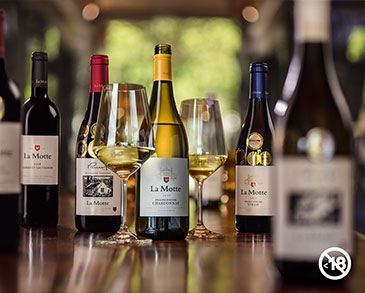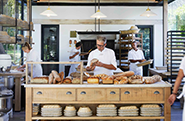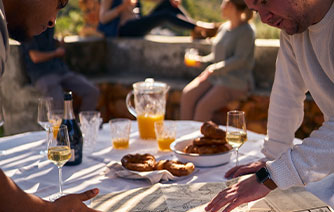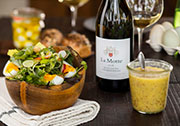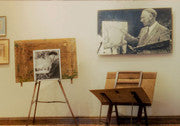Ou Pretoria reeks / Old Pretoria series
Van jongs af het Pierneef in argitektuur belang gestel en tydens die Pierneef-gesin se verblyf in Holland deeltyds opleiding as tekenaar ontvang. Met ‘n pa as argitek is dit ook te verstaan dat die belangstelling en miskien talent reeds vroeg teenwoordig was.
Pierneef meld in ‘n artikel wat die tydskrif The Outspan in September 1949 oor sy Ou Pretoria-reeks geplaas het, dat hy in 1908 met sy studies oor en sketse van Ou Pretoria-huise begin het. Die meeste van die sketse wat vandag in versamelings opgeneem is, dateer uit die tydperk tussen 1911 en 1913. Daar is ‘n aantal sketse van elk van die geboue gemaak en, in sommige gevalle, tot vier sketse van dieselfde huis of gebou.
Pierneef meld ook dat hy spesifiek belang gestel het in ou huise en geboue wat ‘n slegte naam verwerf het weens die assosiasie met die persoon wat daar gewoon het of die doel waarvoor die gebou gebruik is. Hy het ook vermoed dat die geboue nie nog lank sou bestaan nie en het by wyse van die sketse ‘n geïllustreerde rekord begin hou. Soos Pierneef vermoed het, is die geboue en huise nie veel later nie tot niet gemaak. Daar was slegs enkele foto’s van die geboue en hul geskiedkundige waarde is hoofsaaklik in die Pierneef-sketse vasgevang.
Met die sketse wat Pierneef gemaak het, het hy oor aansienlike bronmateriaal beskik om die huise en geboue ‘n dekade later weer te “verken”, dié keer vir die voorstelling daarvan in hout- en linosneë, mediums waarmee hy in die twintigerjare as grafiese kunstenaar uitgeblink het. Nie al die huise wat geteken is, is uiteindelik in hout- of linosneë uitgebeeld nie, maar daar is ten minste elf huise en geboue wat met die sketse verband hou.
Wanneer die Ou Pretoria-sketse en die betrokke hout- of linosneë met mekaar vergelyk word, weerspieël dit hoe Pierneef se benadering tot komposisie gewissel het na gelang van die betrokke medium waarin hy gewerk het.
Die twintigerjare was nie die einde van die Ou Pretoria-reeks nie. In 1948 het Pierneef besluit om van die sketse in olieverfskilderye op ‘n groter skaal te omskep. Vir dié doel het hy spesifieke huise en geboue gekies — dié wat byna vier dekades later nie meer bestaan het nie, aansienlik verander is, of ikoniese persoonlikhede gehuisves het.
Die Suid-Afrikaanse kunstenaar en Pierneef-tydgenoot, Le Roux Smith Le Roux, wat ‘n student en assistent vir Pierneef was tydens die uitvoering van die panele vir die Suid-Afrika Huis in Londen van 1932 tot 1934, het hier die voortou geneem om die olieverfwerke aan die Pretoria Stadsraad te bemark, sodat Pierneef die werke as opdrag vir die Stadsraad se versameling kon uitvoer. In 1949 is altesaam agtien olieverfskilderye van die Ou Pretoria-reeks deur die Stadsraad aangekoop.
From a young age, Pierneef showed an interest in architecture, and he received part-time training as a draftsman during the Pierneef family’s stay in Holland. With his father having been an architect, it is understandable that the interest and perhaps the talent were present since early in his life.
In an article in which The Outspan magazine featured Pierneef’s Old Pretoria series in September 1949, Pierneef mentions that his studies and sketches regarding Old Pretoria houses started in 1908. Most of these sketches in present collections date back to the period between 1911 and 1913. Pierneef made a few sketches of each building and, in some cases, up to four sketches of the same house or building.
Pierneef also mentions that he had a specific interest in old houses and buildings that had been denounced on the grounds of associations with the person who lived there or with the purpose the building had served. He also suspected that the buildings would not be around for much longer and started keeping an illustrated record by means of sketches. True to his suspicion, the houses and other buildings were demolished some time later. There existed only a few photographs of the buildings and their historical value was captured mainly in Pierneef’s sketches.
Thanks to the sketches Pierneef had made he was in possession of a useful source of material to “revisit” these houses and buildings a decade later — this time to portray them in woodcuts and linocuts, mediums in which he excelled as a graphic artist during the 1920s. Not all the houses that were sketched “relived” as woodcuts and linocuts, but at least eleven of them did.
When the Old Pretoria sketches and their respected wood or linocuts are compared, the way in which Pierneef changed his approach to the composition when switching between various mediums is noticeable.
In comparing the Old Pretoria sketches and the corresponding woodcuts or linocuts, one can see clearly how Pierneef’s approach to composition changed in relation to the medium in which he was working.
The 1920s was not the end of the Old Pretoria series. In 1948 Pierneef decided to transform some of the sketches into oil-paintings of a larger scale. For this purpose, he selected specific houses and buildings — those that did not exist after almost four decades, those that had been altered substantially or those in which iconic personalities had lived.
The South African artist and Pierneef contemporary, Le Roux Smith Le Roux, who was a student and an assistant to Pierneef during the execution of the panels for the South Africa House in London from 1932 until 1934, took the lead in marketing the oil renderings to the Preoria City Council, for Pierneef to execute the paintings on commission for the Council’s collection. In 1949 a total of eighteen oil-paintings from the Old Pretoria series were purchased by the Council.
Bronne / Sources
The Outspan. I love Old Pretoria by J H Pierneef. 30 September 1949. p23-25
Le Roux Smith Le Roux. Letter to the City Council of Pretoria. 7 December 1948. NASA, Pretoria. TAB A941 Vol.10 (1402) – Pierneef Documents
Versameling / Collection
Ou Pretoria-sketse / Old Pretoria sketches: Pretoriase Kunsmuseum; Museum Afrika, Johannesburg; Nasionale Argief van Suid-Afrika, Pretoria / Pretoria Art Museum; Museum Africa, Johannesburg; National Archive of South Africa, Pretoria
Ou Pretoria-hout- en linosneë / Old Pretoria wood- and linocuts: La Motte Wynlandgoed / Wine Estate
Ou Pretoria-olieverfskilferye / Old Pretoria oil-paintings: Pretoriase Kunsmuseum / Pretoria Art Museum

